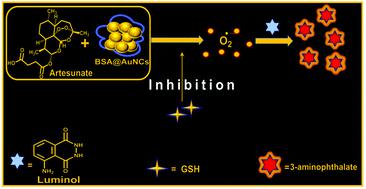当前位置:
X-MOL 学术
›
J. Mater. Chem. B
›
论文详情
Our official English website, www.x-mol.net, welcomes your feedback! (Note: you will need to create a separate account there.)
An ultrasensitive chemiluminescent biosensor for tracing glutathione in human serum using BSA@AuNCs as a peroxidase-mimetic nanozyme on a luminol/artesunate system
Journal of Materials Chemistry B ( IF 7 ) Pub Date : 2021-08-19 , DOI: 10.1039/d1tb01343b Mohamed Ibrahim Halawa 1, 2, 3 , Qing Xia 1 , Bing Shi Li 1
Journal of Materials Chemistry B ( IF 7 ) Pub Date : 2021-08-19 , DOI: 10.1039/d1tb01343b Mohamed Ibrahim Halawa 1, 2, 3 , Qing Xia 1 , Bing Shi Li 1
Affiliation

|
In this work, a nanosensor chemiluminescent (CL) probe for sensing glutathione (GSH) was developed, for the first time, based on its inhibition of the intrinsic peroxidase-mimetic effect of BSA@AuNCs. The endoperoxide linkage of artesunate could be hydrolyzed by BSA@AuNCs resulting in the release of reactive oxygen species (ROS), and the consequent generation of strong CL emission. By virtue of the strong covalent interactions of –S⋯Au–, GSH could greatly suppress the peroxidase-mimetic effect of BSA@AuNCs, leading to a drastic CL quenching. The CL quenching efficiency increased proportionally to the logarithm of GSH concentration through the linearity range of 50.0–5000.0 nM with a limit of detection of 5.2 nM. This CL-based strategy for GSH tracing demonstrated the advantages of ultrasensitivity, high selectivity and simplicity. This strategy was successfully utilized to measure GSH levels in human serum with reasonable recovery results of 98.71%, 103.18%, and 101.68%, suggesting that this turn-off CL sensor is a promising candidate for GSH in biological and clinical samples.
中文翻译:

一种超灵敏的化学发光生物传感器,用于在鲁米诺/青蒿琥酯系统上使用 BSA@AuNCs 作为过氧化物酶模拟纳米酶来追踪人血清中的谷胱甘肽
在这项工作中,基于其抑制 BSA@AuNCs 的内在过氧化物酶模拟效应,首次开发了一种用于传感谷胱甘肽 (GSH) 的纳米传感器化学发光 (CL) 探针。青蒿琥酯的内过氧化物键可以被 BSA@AuNCs 水解,导致活性氧 (ROS) 的释放,从而产生强 CL 发射。凭借-S⋯Au-的强共价相互作用,GSH可以极大地抑制BSA@AuNCs的过氧化物酶模拟效应,导致剧烈的CL猝灭。在 50.0–5000.0 nM 的线性范围内,CL 猝灭效率与 GSH 浓度的对数成比例增加,检测限为 5.2 nM。这种基于 CL 的 GSH 示踪策略展示了超灵敏、高选择性和简单性的优点。
更新日期:2021-09-06
中文翻译:

一种超灵敏的化学发光生物传感器,用于在鲁米诺/青蒿琥酯系统上使用 BSA@AuNCs 作为过氧化物酶模拟纳米酶来追踪人血清中的谷胱甘肽
在这项工作中,基于其抑制 BSA@AuNCs 的内在过氧化物酶模拟效应,首次开发了一种用于传感谷胱甘肽 (GSH) 的纳米传感器化学发光 (CL) 探针。青蒿琥酯的内过氧化物键可以被 BSA@AuNCs 水解,导致活性氧 (ROS) 的释放,从而产生强 CL 发射。凭借-S⋯Au-的强共价相互作用,GSH可以极大地抑制BSA@AuNCs的过氧化物酶模拟效应,导致剧烈的CL猝灭。在 50.0–5000.0 nM 的线性范围内,CL 猝灭效率与 GSH 浓度的对数成比例增加,检测限为 5.2 nM。这种基于 CL 的 GSH 示踪策略展示了超灵敏、高选择性和简单性的优点。


























 京公网安备 11010802027423号
京公网安备 11010802027423号